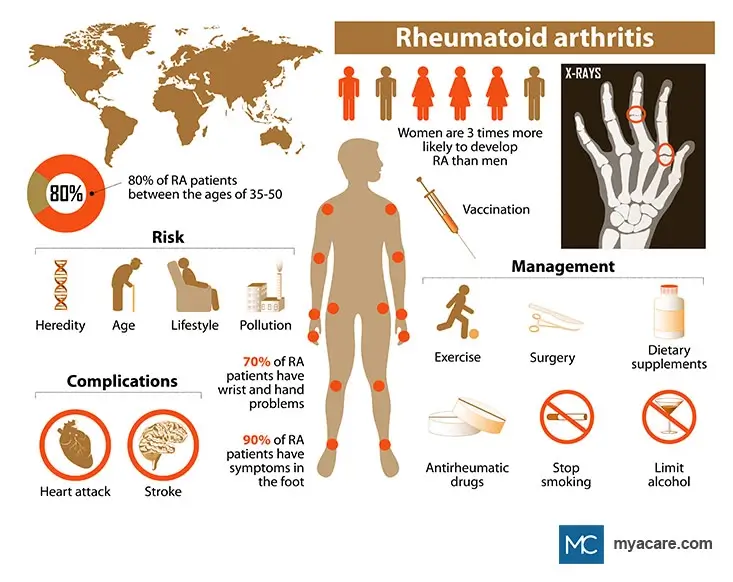Rheumatoid Arthritis and Its Side Effects on the Body

Rheumatoid arthritis is classed as one of the autoimmune diseases that affect the joints but can have wide-reaching effects on the body. Autoimmune conditions happen when there is a problem with the immune system. Rheumatoid arthritis is a debilitating condition that afflicts 1% of the population. In rheumatoid arthritis, the person’s own immune system attacks the synovium (the lining of the joints).

Causes of Rheumatoid Arthritis
The exact cause of rheumatoid arthritis is not known; however, environmental factors and gene mutations are suspected to play a role in activating this autoimmune disease. Viral infections and environmental toxins could possibly act as triggers for rheumatoid arthritis (RA).
Risk Factors for Rheumatoid Arthritis
There are certain factors that increase the chance of a person developing RA. These are described below.
- Obesity: People who are significantly overweight have a higher risk of RA than those of normal weight.
- Smoking: Smokers are more predisposed to getting RA and having children with RA. Children exposed to secondhand smoke are more likely to develop RA in adulthood.
- Genes: Individuals with certain genomes are more apt to have RA. The HLA (human leukocyte antigen) class II genotypes seem to make people more prone to RA.
- Age and sex: Older people and females are most likely to develop RA. The disease is in fact three times more common in females than males.
- Females and births: Women who have never given birth also seem to be more prone to RA than other people.
- Nutrition: A diet high in salt, sugar, and meat may increase RA risk.
At what age can you get rheumatoid arthritis?
Unlike osteoarthritis, RA can develop at any age. Symptoms usually first appear in people between ages 30 to 50 but sometimes there is late-onset RA in people over 60.
What are the Symptoms of Rheumatoid Arthritis?
The symptoms of RA may come and go. When symptoms are worst it is called a RA flare-up and when they subside the person is said to be in remission.
The main symptoms of RA are listed and described below.
- Joints: The joints of a person with RA are stiff and swollen, painful and red due to the inflammation. Joints may also feel warm to the touch. The most frequently affected joints are those of the extremities and the wrists and hands but other joints such as knees and elbows can also be affected.
- Fever: The individual who has RA often has a low-grade fever of about 100oF.
- Appetite loss: People with this form of arthritis often eat less than normal.
- Fatigue: Feeling tired is common with people who have RA because of the unusual immune system response that is occurring. People feel too exhausted to easily do daily activities of life.
Additional symptoms may occur in some people when other organs are affected by RA.
The Side Effects of Rheumatoid Arthritis
Rheumatoid arthritis has effects on the entire body even though the focus is often on the joints. This is a result of the inflammatory response, which affects many organ systems in the body. Close to half of all RA patients experience these widespread effects that become more evident as the illness progresses.
The many side effects of RA are described and discussed further below.
Joints, Bones, and Extremities
- Edema: RA can cause problems with the drainage of lymph in the lymphatic system. The inflammation also causes tissue swelling. This all leads to pitting edema in the extremities such as the arms, feet, and hands.
- Osteitis: This is inflammation of the bone marrow and can happen in the later stages of RA disease. In these cases, the inflammation continues through the joint and into the marrow of the bone.
- Deformity of joints: The inflammatory response in joints, especially those of the fingers and hands, can result in deformity, making using the hands and fingers difficult.
- Subcutaneous nodules: Nodules may develop under the skin on the outermost surface of the elbow and knee joints.
- Wrist synovitis: This is when the wrist swells up because of RA affecting the joint; the synovitis can result in carpal tunnel syndrome as tissue swells up and compresses the median nerve in the wrist area.
- Bunions and claw toes: A bunion is a painful bump that forms near the big toe while claw toes are when the toes deform and bend into odd angles.
- Fibromyalgia: Patients with RA often also develop fibromyalgia.
Eye, Glands, and Skin
- Ocular issues: Problems with the eyes due to RA include keratoconjunctivitis sicca (dry eyes) and episcleritis (inflammation of episcleral tissue), or scleritis (inflammation of the sclera). Eye drops help alleviate these problems.
- Secondary Sjögren's syndrome (SS): This is when the lacrimal and salivary glands are impacted affecting secretions. There may be less tears and saliva produced than usual. This leads to dry eyes and mouth and also dry skin.
Heart, Blood vessels, Kidneys, and Lungs
- Cardiac issues: Cytokines are chemicals produced by immune system cells. In inflammatory responses, these chemicals can harm both joints and blood vessels making heart and blood vessel problems more likely. Inflammation increases plaque in blood vessels increasing the chances of a future heart attack due to atherosclerosis that develops. Steroids used to treat RA can also cause hypertension (high blood pressure), which strains the cardiovascular system.
- Rheumatoid vasculitis: This is when the blood vessels are affected by the RA. The mortality rate can be quite high, up to 50% in 5 years with this condition. Vasculitis happens as white blood cells infiltrate and destroy the walls of the blood vessels. This can have widespread effects on the organs of the body, even impacting the digestive system in some cases.
- Pulmonary issues: RA can lead to interstitial lung disease (ILD). In fact, ILD is the most common of the lung problems associated with RA and it is associated with a higher risk of disability and mortality for RA patients.
- Kidney problems: RA can cause kidney dysfunction. It can result in chronic kidney disease from both inflammation and atherosclerosis.
Nervous System and Mental Health
- Cervical spine: Patients with severe RA can develop lesions on the spinal cord and develop an unstable spinal cord. This is a serious complication of RA that needs to be assessed; it may require surgical intervention.
- Brain fog: The inflammation of blood vessels in the brain can lead to neurological issues including poor concentration and memory.
- Neuropathy: A swollen joint may press on a nerve resulting in paresthesia (a tingling sensation) or burning in the nerves.
- Depression: It is quite common for individuals with RA to also suffer from depression. The exhaustion and pain of the illness often contribute to depression, with as many as 17% of people with RA having depression.
- Anxiety: The stress of coping with RA and its many challenges can lead to anxiety.
- Self-esteem: RA is disabling and can impact self-esteem in a negative way as people are less able to function in their daily lives. They may also feel self-conscious if they have deformed hands and fingers.
Diagnosis of Rheumatoid Arthritis
A person who has 3 or more swollen and sore joints and who has had the condition for about 6 weeks may have RA. Although such physical symptoms may suggest RA, a definitive diagnosis is done with further tests.
RA can be diagnosed by blood tests showing elevated levels of the following:
- Serum rheumatoid factor (RF)
- Anti-CCP antibody
- Erythrocyte sedimentation rate (ESR)
- C-reactive protein (CRP)
X-rays and MRI tests are often done to check how the illness is progressing by noting the condition of the affected joints.
Treatment Methods for Rheumatoid Arthritis
Treatment of RA can be difficult but some of the options are given below:
- Heat therapy: Applying heat to affected areas can decrease stiffness.
- Specific exercises: This can help increase the range of motion of stiff joints.
- Joint splinting: This can help with inflammation of the joints.
- Massage: A trained physical therapist can help through massage.
- Arthroplasty: Surgery to replace deformed knees and hips may be indicated and beneficial in severe cases.
- Nonsteroidal anti-inflammatory drugs (NSAIDs): These can help reduce inflammation and help alleviate pain.
- Disease-modifying antirheumatic drugs: Methotrexate is one such medication that is often prescribed for people who have RA.
- Drugs classified as biological agents: Tumor necrosis factor (TNF)-alpha antagonists and B-cell depleters are examples of these medications. These types of medicines help slow the progression of RA.
Note: certain treatment methods can also have unpleasant side effects. NSAIDs can cause stomach upset and bleeding while methotrexate can make you dizzy and take away your appetite.
Conclusion
Rheumatoid arthritis has multiple effects on the body causing systemic inflammation. The physical and psychological effects of the condition need to be recognized and treated along with the usual therapeutic methods used for managing RA. Dangerous complications of RA include heart attacks and strokes, which can prove fatal.
To learn about Rheumatoid Arthritis flare-ups, what to know and how to cope, please click here.
To search for the best Rheumatology healthcare providers in Croatia, Germany, India, Malaysia, Spain, Thailand, The UAE, The UK and the United States, please use the Mya Care search engine.
To search for the best healthcare providers worldwide, please use the Mya Care search engine.

Dr. Rae Osborn has a Ph.D. in Biology from the University of Texas at Arlington. She was a tenured Associate Professor of Biology at Northwestern State University, where she taught many courses to Pre-nursing and Pre-medical students. She has written extensively on medical conditions and healthy lifestyle topics, including nutrition. She is from South Africa but lived and taught in the United States for 18 years.
Sources:
Featured Blogs



